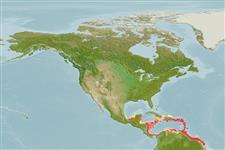Common names from other countries
>
Ophidiiformes (Cusk eels) >
Ophidiidae (Cusk-eels) > Ophidiinae
Etymology: Lepophidium: Latin, lepus, leporis = rabbit + Greek, ophis = serpent (Ref. 45335).
More on author: Robins.
Environment: milieu / climate zone / depth range / distribution range
Écologie
marin démersal; profondeur 27 - 165 m (Ref. 91765). Tropical; 21°N - 2°N, 97°W - 49°W (Ref. 91765)
Western Atlantic: along the northern coast of South America from Colombia to Cabo Orange, Brazil (north of the mouth of the Amazon); including Gulf of Campeche, Mexico, Nicaragua, Panama, shelf area from northern Puerto Rico to the US Virgin Islands.
Taille / Poids / Âge
Maturity: Lm ? range ? - ? cm
Max length : 27.0 cm SL mâle / non sexé; (Ref. 91765); common length : 18.0 cm TL mâle / non sexé; (Ref. 5217)
Description synthétique
Clés d'identification | Morphologie | Morphométrie
Épines dorsales (Total) : 0; Rayons mous dorsaux (Total) : 127 - 130; Épines anales: 0; Rayons mous anaux: 104 - 112; Vertèbres: 69 - 72. This species is characterized by the following: usual number of vertebrae, precaudal 15 (14), caudal 56-57 (54-58), total 71-72 (69-72); fin rays, dorsal 127-130 (125-133), anal 106-108 (104-112) pectoral 20-21 (22); pyloric caeca usually 3 (1-4), most often with 2 in one tier and 1 in second, when 4, they are 3+1; first gill arch with rudimentary rakers 2 on the upper arm, 4 (rarely 5) developed rakers on the lower limb, usually 2 (1-3) rudimentary rakers anteriorly on the first arch; total rakers usually 8-9; dorsal-fin origin between neural spines 2-3 (18 specimens) or 3-4 (11 specimens), in most instances is almost directly over neural spine 3 (Ref. 91765).
Common species (Ref. 34024). Found on the continental shelf, on soft bottom (Ref. 5217). Oviparous, with oval pelagic eggs floating in a gelatinous mass (Ref. 205).
Life cycle and mating behavior
Maturities | Reproduction | Spawnings | Egg(s) | Fecundities | Larves
Robins, C.R., R.H. Robins and M.E. Brown, 2012. A revision of Lepophidium (Teleoastei, Ophidiidae), with descriptions of eight new species. Bulletin of the Florida Museum of Natural History 52(1):1-94. (Ref. 91765)
Statut dans la liste rouge de l'IUCN (Ref. 130435)
CITES (Ref. 128078)
Not Evaluated
Menace pour l'homme
Harmless
Utilisations par l'homme
Outils
Articles particuliers
Télécharger en XML
Sources Internet
Estimates based on models
Preferred temperature (Ref.
115969): 21.7 - 27.1, mean 25.6 (based on 64 cells).
Phylogenetic diversity index (Ref.
82804): PD
50 = 0.5000 [Uniqueness, from 0.5 = low to 2.0 = high].
Bayesian length-weight: a=0.00234 (0.00101 - 0.00543), b=3.16 (2.98 - 3.34), in cm Total Length, based on LWR estimates for this Genus-body shape (Ref.
93245).
Niveau trophique (Ref.
69278): 3.6 ±0.7 se; based on size and trophs of closest relatives
Résilience (Ref.
120179): Haut, temps minimum de doublement de population inférieur à 15 mois (Preliminary K or Fecundity.).
Fishing Vulnerability (Ref.
59153): Low vulnerability (23 of 100).
